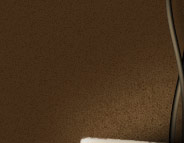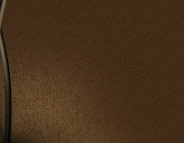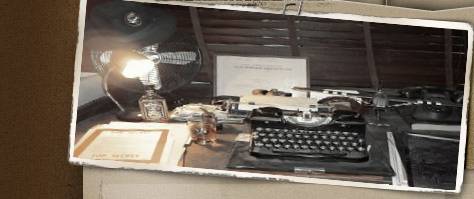|

|
|
On Friday, May 6th 2011, George Roth
from Utah, a 92 year old American
veteran of the 82nd Airborne
Division, visited the town of Grave
in The Netherlands.
In September 1944 Roth fought near
Grave as a Private First Class in
"E" /Company of the 504th Parachute
Infantry Regiment during Operation
"Market Garden".
Having visited the town several
times after World War Two, he wished
to see Grave one more time,
accompanied by his niece Caroline
Shelton. A tour of the town and a
visit to the Maas river bridge, one
of the objectives of the 504th, had
been planned for this sunny May-day.
PFC Roth had been the only American
veteran in the Liberation Day parade
in Wageningen, Holland the previous
day, where he had been hailed 'like
a general'.
George Roth is the last survivor of
"Easy" Company of the 504th
Parachute Infantry regiment.
We will first briefly describe this
company’s actions on D-Day of
Operation Market Garden.
|
|
"Easy" Company’s coup-de-main
raid on Grave bridge
Company Commander CPT Walter S.
VanPoyk's task had been to capture
the road bridge at Grave. This steel
bridge spanned the Maas River and
had been a vital water crossing in
the chain of bridges that were to be
captured by airborne forces allowing
an armored army to drive North into
Holland.
Following military doctrine a plan
was made to attack this bridge both
ends at once and VanPoyk's "E"
Company was chosen to land on the
Southern bank of the River Maas on
soil of the province of
North-Brabant.
On Sunday September 17th 1944 it was
platoon leader 1LT John S. Thompson
and his stick of about 14 other
paratroopers who landed closest to
the bridge. After a brief firefight,
using bazookas and automatic rifle
and sub machinegun fire to silence
the German defenders at the bridge,
the objective was captured. |
|
click to
enlarge:
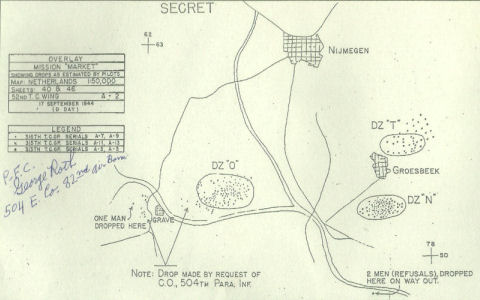
After action
drop
pattern map of paratroopers of the 82nd
Airborne Division |
|
Roadblock of Hell’s Highway
Meanwhile the rest of the company,
including PFC George Roth, had
landed near the village of Velp,
about a mile south of their
designated Drop Zone. Understanding
that the nearest sizable unit of
paratroopers would be the men of the
501st Parachute Infantry Regiment
(of the 101st Airborne Division) and
that their location was about
fifteen miles South of him, CPT
VanPoyk assembled his men and
decided to create a roadblock South
of Grave. The Maas river road bridge
was already in his company's hands.
Blocking the highway leading to the
bridge would prevent the Germans
from attacking it. On the map
VanPoyk selected the bend in the
main road (later dubbed "Hell's
Highway" by the paratroopers) at the
hamlet of "De Elft" for his road
block here: |
|
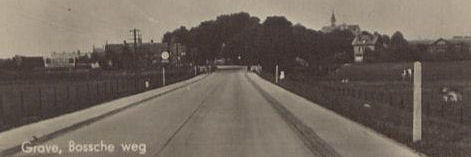 |
At a T-junction between Velp and the
highway, the men of "E" Company took
Hoogveldseweg. They were seemingly
sent in the right direction by a
damaged roadside crucifix. Only
Christ’s right arm was still intact,
the other arm (even today) destroyed
by shrapnel or gunfire.
Christ's remaining arm indicated the
route to the highway:
|
|
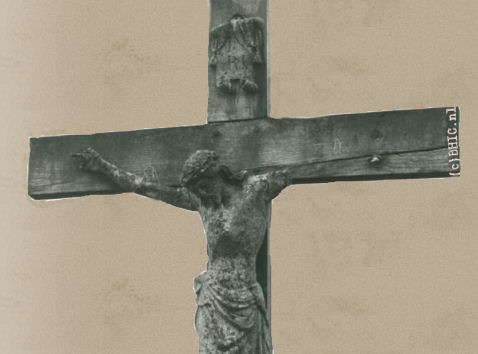 |
On location on Hoogveldseweg
in Velp, we found the crucifix with
an intact statue of Christ.
From a staff member of the Grave
Museum we learned that the damaged
crucifix had only been replaced in
the year 2010. |
|
click to enlarge:
.jpg)
.jpg) |
The men of "E" Company took their
positions in the few houses of the
hamlet, broke all windows in a
pigsty of the Driessen family and
covered the highway from there. CPT
VanPoyk set up his CP in a café
named "De Elft".
Meanwhile, LT Thompson, who had been
relieved at the bridge by other
paratroopers of 2nd Battalion of the
504th, had joined VanPoyk's men.
There had been a few small
skirmishes with Germans from the
nearby garrison before a tank had
come up to the position almost at
sundown. At the last moment the
paratroopers recognized it as a
German tank.
The panzer was repelled but not
before it had taken several
casualties among VanPoyk's men.
The men of "Easy" Company held the
roadblock until the tanks of the
British 30th Corps finally reached
their positions by midmorning on the
19th of September 1944.
|
|
click to enlarge:
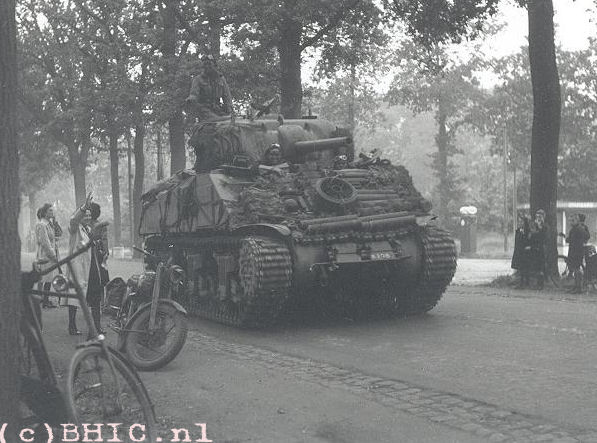
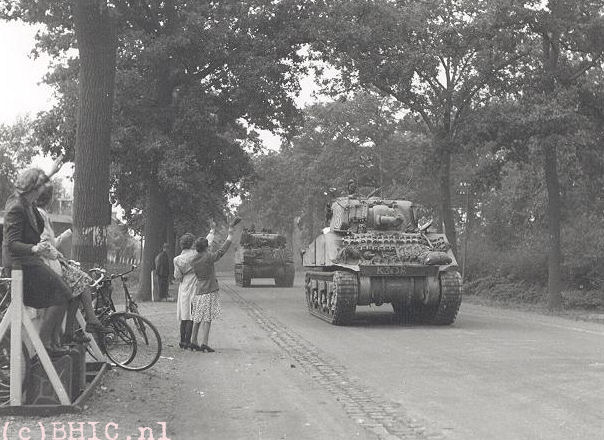
Tanks of the British
30th Corps have reached "De Elft", "Easy" Company's
position South of Grave |
Tour of Grave and Lt. Thompson
Bridge
The last man of “E”/504th landed in
Grave at exactly 11:00 AM. By boat
over the river Maas this time. He
was welcomed by Mayor Sjoukje
Haasjes and Jan Timmermans; a local
historian. After coffee, autographs
and interviews with
local media, George and his
party, including
battledetective.com, were led
through Grave. |
|
click to enlarge:
_small.jpg) _small.jpg) _small.jpg) |
Mayor Haasjes acted as George’s
personal guide. This created a
picture similar to a Signal Corps
photograph taken in September 1944
and often captioned as taken in
Grave:
|
|
click to enlarge:
.jpg) .jpg) .jpg) .jpg) 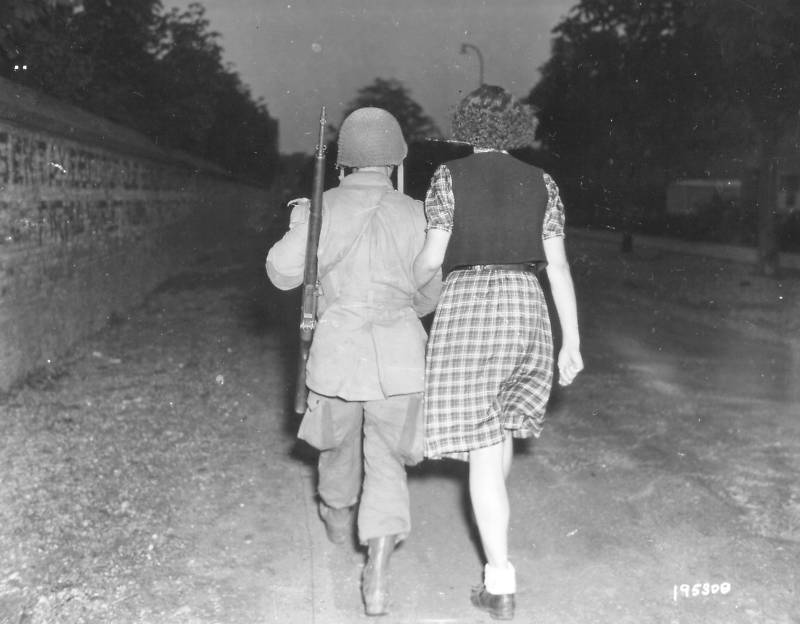 |
|
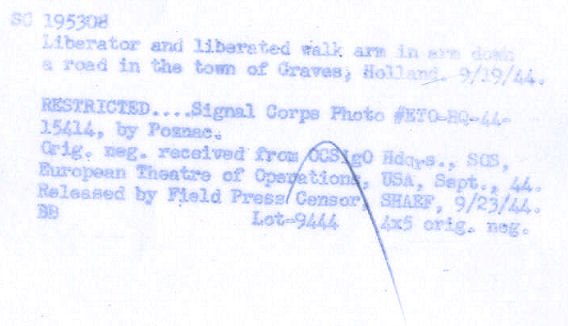
Caption on backside
of the Signal Corps Photograph:
Liberator
and liberated walk arm in arm down
a road in the town of Graves,
Holland. 9/19/44. |
|
The tour made a stop at the old town
hall on Hoofdwagt where in September
1944 the commander of 2nd Battalion,
Major Wellems, had his command post,
codenamed "Cider White CP". |
|
.jpg)
Maarten Dekkers (Left) of the
National Liberation Museum in
Groesbeek
and George Roth hold photo of Major
Wellems in front of his former
Command Post;
"Cider White CP". Jan Timmermans
of the
"Graafs Museum" in Grave (Right) looks
on. |
|
click to enlarge:
 |
Dog Robber
George Roth remembered:
"During the Battle of the Bulge,
the doctors had to amputate two of
my toes because of frostbite.
I was given light duty as an aide to
Major Wellems; a job we called "dog
robber" in 1944. The Major ordered
me to polish his paratrooper boots.
After I had done that a couple of
times I decided that this was not
what I had my special airborne
training for and made a sloppy shine
job of it. The Major went mad and
fired me as his dog robber. That was
what I had intended."
Across the street from the old town
hall is the church in the center of
Grave. From the steps above the
former entrance to CP Cider White we
took this Now&Then- comparison:
|
|
click to enlarge:
 |
It shows citizens of Grave on the
evening of September 17th, 1944
cheerfully displaying one of the
parachutes that had brought the
American liberators to their
hometown.
|
|
click to enlarge:
.jpg) |
Later the atmosphere became grimmer
when the heads of local girls, who
had 'fraternized' with soldiers from
the German occupying forces, where
shaven to punish them. An American
Signal Corps photographer takes
close-up pictures while a Dutch
Marechaussee (military police) looks
and waves into the camera in the
center of the "Then-"photo".
- This "Now-"photo was taken on
30MAR2019 - |
|
A group of re-enactors with
historical vehicles stood ready in
the next street for the ride to the
Maas river bridge. George was helped
in his WWII uniform by his niece,
calling her his temporary "dog
robber". |
click to enlarge:
_small.jpg) |
|
George was amazed to see paratrooper
/ re-enactor Robbie Braam. Rob is at
about the age of George during the
time of his first 'visit' to
Holland, but almost twice as tall.
PFC Roth then told a story about a
tall paratrooper in his company who
had to carry the gigantic mortar
base plate into battle. |
|
click to enlarge:
.jpg)
.jpg) |
Lt. Thompson Bridge
At the Maas River bridge, renamed
"John S. Thompson brug" in 2004, PFC
George Roth and Mayor Haasjes laid a
wreath at the monument. |
|
click to enlarge:
_small.jpg)
_small.jpg)
_small.jpg)
_small.jpg) |
A short address by Jan Timmermans
ended the ceremony at the bridge.
It also marked the end of this
report. |
|
click to enlarge:
_small.jpg)
_small.jpg)
Goodbye: PFC George
Roth as he must have
looked during the
Liberation Day Parade
in Wageningen
the previous day |
|
Back to Commemoration Page |
